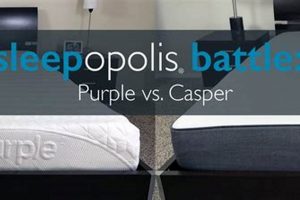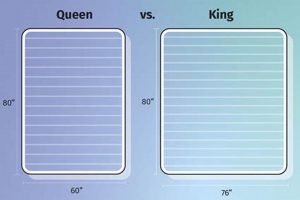The selection of a sleep surface is a significant decision impacting rest quality and physical well-being. Two primary options, characterized by their feel, offer distinct support levels. One provides a yielding, soft sensation, while the other delivers a stable, uncompressing surface. These contrasting characteristics cater to diverse preferences and physiological needs, influencing spinal alignment and pressure point relief.
The degree of support offered by a sleep surface is crucial for maintaining proper spinal alignment during sleep, potentially reducing back pain and promoting restful sleep. Historically, preferences for a particular support level have evolved, influenced by advancements in sleep science and mattress technology. Considerations of body weight, sleeping position, and individual comfort levels play a vital role in determining the optimal choice for each individual.
This analysis will examine the characteristics of both types, outlining their respective benefits, ideal user profiles, and potential drawbacks. Further considerations regarding construction materials, durability, and specific health conditions will be discussed to aid in making an informed selection of a sleep system. This facilitates a better understanding of how individual needs align with the properties of different support levels to enhance the sleep experience.
Selection Guidance
The following considerations should inform the selection process when evaluating differing sleep surface options.
Tip 1: Prioritize Spinal Alignment: Evaluate how each option supports the natural curvature of the spine in various sleeping positions. Proper alignment minimizes pressure points and reduces the likelihood of back pain.
Tip 2: Consider Body Weight: Individuals with higher body mass may require a firmer option for adequate support and to prevent excessive sinking, which can compromise spinal alignment.
Tip 3: Evaluate Sleeping Position: Side sleepers typically benefit from a softer option to cushion the shoulders and hips. Back and stomach sleepers often require a firmer surface to prevent the hips from sinking too deeply.
Tip 4: Assess Pressure Point Relief: Pay attention to how each option distributes body weight. Adequate pressure relief is crucial for preventing discomfort and promoting healthy circulation.
Tip 5: Consider Partner Preferences: If sharing a bed, consider the sleeping preferences and needs of both individuals. Compromise may be necessary, or a hybrid option that addresses differing needs may be suitable.
Tip 6: Research Construction Materials: Different materials, such as memory foam, latex, and innersprings, offer varying levels of support, comfort, and durability. Understand the characteristics of each material before making a decision.
Tip 7: Trial Period is Essential: Whenever feasible, take advantage of any trial period offered by the retailer. Sleeping on a surface for an extended period is the most effective way to determine its suitability.
These guidelines offer a framework for navigating the selection process. Understanding individual needs and aligning them with the characteristics of different sleep surfaces is paramount.
The final section of this guide offers additional resources and insights to further aid in the decision-making process.
1. Support and Spinal Alignment
Spinal alignment during sleep is directly affected by the support characteristics of the sleep surface. A sleep surface that is too yielding allows the heavier parts of the body, such as the hips and shoulders, to sink too deeply, leading to spinal misalignment. Conversely, a surface that is too firm fails to conform to the body’s natural curves, placing undue pressure on certain areas and potentially leading to discomfort or pain. The ideal support level maintains the spine’s natural curvature, distributing weight evenly and minimizing stress on joints and muscles.
The effect of a chosen support level on spinal alignment is often observed in individuals experiencing chronic back pain. For example, an individual with scoliosis requires a surface that conforms to their unique spinal curvature to prevent exacerbation of pain and discomfort. A firmer surface, while generally considered supportive, may not adequately address the specific needs of this individual. Similarly, a side sleeper may benefit from a more yielding surface that allows the shoulder and hip to sink in, maintaining spinal alignment. However, a firmer option might cause pressure buildup and discomfort in these areas. The practical significance of understanding this connection lies in the ability to select a sleep surface that proactively minimizes the risk of musculoskeletal issues.
Optimal spinal alignment during sleep is a crucial factor in overall health and well-being. The connection between the support characteristics of a sleep surface and spinal alignment must be carefully considered. Understanding these effects enables informed decision-making, ultimately contributing to more restful and restorative sleep. Choosing appropriate sleep system directly contributes to long-term musculoskeletal health and enhanced sleep quality.
2. Pressure Point Relief
Pressure point relief, a crucial aspect of sleep comfort, is directly related to the firmness level of a sleep surface. When lying down, the body’s weight is distributed across a limited number of contact points. Inadequate pressure relief can constrict blood flow and cause discomfort, leading to tossing and turning, thereby disrupting sleep. Different firmness levels address this issue with varying degrees of effectiveness. A surface that is too firm concentrates pressure on bony prominences such as hips, shoulders, and heels. A yielding surface, conversely, allows these areas to sink in, distributing weight more evenly and reducing localized pressure.
The choice between a yielding and firm support system can significantly affect individuals with conditions such as arthritis or fibromyalgia, where heightened sensitivity to pressure is common. For example, an individual with arthritis may find that a surface that is too firm exacerbates joint pain. Conversely, an individual recovering from surgery may require a firmer surface to maintain spinal alignment and minimize pressure on the incision site. This relationship highlights the practical importance of understanding how different firmness levels affect pressure distribution.
Effective pressure point relief is a key component of restorative sleep. Selecting an appropriately firm sleep surface can minimize pressure-induced discomfort and promote undisturbed rest. Consideration of individual health conditions, sleeping positions, and weight distribution is essential to make an informed decision. By aligning the firmness level with specific needs, individuals can potentially enhance sleep quality and improve overall well-being. The knowledge of appropriate Pressure Point Relief is necessary for a good sleep
3. Body Weight Distribution
Body weight distribution is a pivotal factor in determining the optimal sleep surface. The interplay between body mass and mattress firmness dictates the degree of support and comfort experienced during sleep. An understanding of how different firmness levels accommodate varying weight distributions is essential for selecting a mattress that promotes spinal alignment and pressure relief.
- Support and Sinkage
The relationship between body weight and sinkage directly impacts spinal alignment. A higher body weight on a yielding surface results in greater sinkage, potentially leading to spinal misalignment. A firmer surface resists excessive sinkage, providing the necessary support to maintain proper alignment. Conversely, a lower body weight may not engage a firmer surface sufficiently, leading to discomfort. The amount of sinkage dictates support.
- Pressure Mapping
Body weight significantly influences pressure distribution across the sleep surface. Heavier individuals exert greater pressure on contact points such as the hips and shoulders. A mattress failing to accommodate these pressure points can lead to discomfort and disrupted sleep. Mapping pressure points and selecting a mattress that evenly distributes weight is essential for minimizing discomfort.
- Surface Area Contact
Body weight affects the surface area in contact with the mattress. Heavier individuals have a larger contact area compared to lighter individuals. A mattress must be capable of providing consistent support across this larger contact area. Uneven support can lead to pressure imbalances and discomfort. Contact with a good surface and support will improve sleep quality.
- Long-Term Deformation
The long-term deformation of a mattress is directly related to the body weight it supports. A mattress subjected to higher body weight is more prone to sagging and loss of support over time. Selecting a mattress with robust construction and high-density materials is crucial for maintaining its support characteristics over its lifespan.
Considering body weight distribution is essential when evaluating between differing mattress firmness options. An ideal mattress will evenly distribute weight, minimize pressure points, and maintain spinal alignment. Prioritizing these factors leads to better sleep quality and long-term musculoskeletal health. Understanding body weight and its contact point and pressure distribution allows a more customized choice for both mattress types.
4. Sleeping Position Preference
Sleeping position preference significantly influences the perceived comfort and support provided by different mattress types. The alignment of the spine, distribution of body weight, and pressure point relief all vary depending on whether one sleeps on their side, back, or stomach. Consequently, the ideal mattress firmness is intimately linked to habitual sleep posture. A disconnect between mattress firmness and sleeping position can lead to discomfort, disrupted sleep, and potential musculoskeletal issues.
Side sleepers, for example, often benefit from a more yielding surface. This allows the shoulder and hip to sink into the mattress, maintaining spinal alignment and reducing pressure on these joints. A firmer surface, conversely, may not provide sufficient give, leading to pressure buildup and discomfort. Back sleepers generally require a more supportive surface to prevent the hips from sinking excessively, which can cause lower back pain. A medium-firm to firm mattress often provides the necessary support while still offering some contouring for comfort. Stomach sleeping is generally discouraged due to its tendency to flatten the natural curve of the spine and strain the neck. However, if this position is preferred, a firmer mattress is typically recommended to minimize sinkage and maintain spinal alignment as much as possible. The understanding of these relationships contributes to a more informed mattress purchase.
In conclusion, sleeping position preference is a critical factor in the selection of a sleep surface. Recognizing the distinct needs of side, back, and stomach sleepers allows for a more personalized and effective choice. While individual preferences and body types may vary, aligning mattress firmness with sleeping position preference is a crucial step towards optimizing sleep quality and promoting musculoskeletal health. The challenge lies in accurately identifying one’s primary sleeping position and translating this knowledge into a suitable mattress selection. This understanding is integral to the broader theme of optimizing sleep health through informed decision-making.
5. Long-Term Durability
Long-term durability represents a critical consideration when evaluating sleep surfaces. The ability of a sleep surface to maintain its original support characteristics and comfort level over an extended period directly influences its value proposition. Differences in construction, materials, and design between varying firmness levels impact the rate and manner in which a sleep surface degrades. Therefore, understanding the factors that contribute to longevity is essential for making an informed purchase.
- Material Composition and Density
The materials used in the construction of a sleep surface, along with their density, are primary determinants of long-term durability. Higher density foams, for example, resist compression and deformation more effectively than lower density counterparts. Similarly, the type and gauge of coils in an innerspring system influence its ability to maintain support over time. A sleep surface constructed with high-quality, durable materials is more likely to resist sagging and maintain its original firmness and comfort level, while lower-quality materials are more susceptible to premature wear and tear. An example is using high-density memory foam versus low-density polyurethane foam. The former will retain its shape and support longer, translating to greater durability.
- Construction Techniques and Layering
The methods used to assemble the various components of a sleep surface also contribute to its longevity. Reinforced edges, for instance, prevent the perimeter of the mattress from collapsing over time, a common issue that reduces usable surface area and compromises support. Similarly, the layering of different materials and the use of durable adhesives influence the overall structural integrity. Mattresses with robust construction and meticulous attention to detail are generally more resistant to wear and tear. Reinforced edge support extending the lifespan and sleep surface of a mattress is an effective method to avoid collapsing edges over long term of usage.
- Usage Patterns and Weight Load
The manner in which a sleep surface is used, including the weight it supports and the sleeping habits of the individual, affects its lifespan. Heavier individuals place greater stress on the materials, potentially accelerating wear and tear. Similarly, consistently sleeping in the same spot on the mattress can lead to localized compression and sagging. Rotating the sleep surface regularly and using a supportive foundation can help to distribute weight evenly and prolong its lifespan. A heavier user may compress a less durable plush mattress quicker than a firm mattress using the same material with greater density, showing that usage contributes to durability.
- Warranty and Maintenance Practices
The presence of a comprehensive warranty indicates the manufacturer’s confidence in the durability of the product. A warranty typically covers defects in materials and workmanship, providing recourse in the event of premature failure. Proper maintenance practices, such as using a mattress protector and following the manufacturer’s cleaning instructions, can also extend the lifespan of a sleep surface. Regular cleaning can prevent the build-up of dust mites and allergens, which can degrade the materials and compromise hygiene, and using protector to prevent sweat. Taking care of mattress extends usage and lifespan.
The long-term durability of a sleep surface is a multifaceted characteristic influenced by material quality, construction techniques, usage patterns, and maintenance practices. Understanding these factors is crucial for selecting a mattress that provides consistent support and comfort over its intended lifespan. When evaluating the durability of different sleep surfaces, consider the quality of materials, the construction techniques employed, and the manufacturer’s warranty. Taking time to understand these components is the best way to determine the long-term durability of a mattress and choose what suits individual needs the best.
Frequently Asked Questions
The following questions address common inquiries regarding sleep surface selection, focusing on the distinction between differing firmness options and their suitability for various individuals.
Question 1: What are the primary differences?
One offers a yielding surface with significant contouring, while the other provides a more rigid and uncompressing feel. The choice between the two hinges on individual preferences for support and pressure relief.
Question 2: How does body weight influence the selection?
Individuals with higher body mass typically require a firmer option to ensure adequate support and prevent excessive sinkage. Lighter individuals may find a yielding option more comfortable.
Question 3: Does sleeping position dictate the ideal choice?
Sleeping position is a crucial determinant. Side sleepers often benefit from the contouring of a yielding option, while back sleepers generally require the support of a firmer surface.
Question 4: What role does spinal alignment play?
Maintaining proper spinal alignment is paramount. The chosen sleep surface should support the natural curvature of the spine, minimizing pressure points and preventing discomfort.
Question 5: How does one assess long-term durability?
Material quality, construction techniques, and warranty coverage are key indicators of long-term durability. Higher density materials and robust construction are generally more resilient.
Question 6: Can specific health conditions influence the decision?
Certain health conditions, such as arthritis or back pain, can significantly impact the suitability of different sleep surfaces. Consulting with a healthcare professional is advisable in such cases.
In summary, informed selection requires careful consideration of individual needs and preferences. Understanding the key distinctions between these sleep surface options enables individuals to make choices that promote restful sleep and overall well-being.
The following section provides resources for further research and assistance in making an informed selection of a sleep system.
Plush Mattress vs Firm Mattress
This exploration of plush mattress vs firm mattress options has illuminated the critical factors influencing sleep quality and musculoskeletal health. The analysis underscores the importance of considering individual body weight, sleeping position, and any pre-existing health conditions when selecting a sleep surface. Long-term durability, material composition, and construction techniques emerge as key determinants of a mattress’s ability to provide sustained support and comfort. Ultimately, the informed alignment of individual needs with the characteristics of each mattress type dictates the potential for restorative sleep.
The decision to purchase a plush mattress vs a firm mattress represents a significant investment in long-term well-being. Further research into specific materials and construction methods, coupled with in-person testing whenever possible, is strongly encouraged. The understanding gained through informed decision-making empowers individuals to optimize their sleep environment and, consequently, enhance their overall quality of life.







